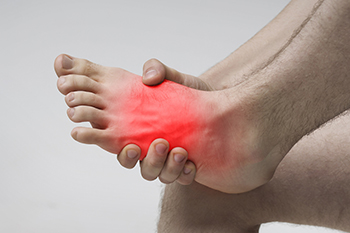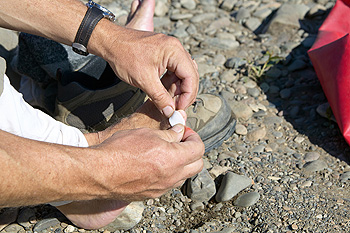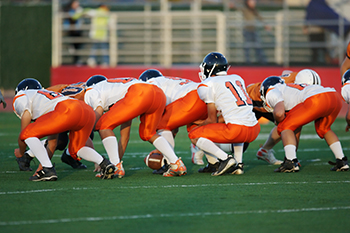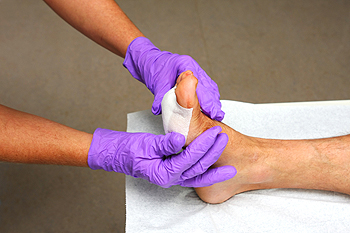February 2025
How Fibromyalgia Affects the Feet

Fibromyalgia can cause persistent foot pain, often affecting the heels, arches, toes, and ankles. This chronic disorder heightens sensitivity in the nervous system, making weight-bearing activities uncomfortable. Many patients experience aching, burning, or stabbing sensations in their feet, which can fluctuate in intensity. Stiffness, swelling, and tenderness are also common, particularly in the morning or after prolonged standing. Poor circulation, common in fibromyalgia, may contribute to cold feet or a tingling sensation. Wearing ill-fitting shoes or prolonged pressure on the feet can worsen symptoms, making everyday movement difficult. While fibromyalgia does not directly damage the foot’s structure, ongoing pain and discomfort can alter walking patterns, leading to strain in the ankles and an increased risk of imbalance. A podiatrist can assess your foot mechanics, recommend supportive footwear, and provide custom orthotics to ease discomfort. They may also suggest additional treatments to improve mobility and alleviate pain. If you have foot pain connected to fibromyalgia, it is suggested that you schedule an appointment with a podiatrist for treatment options.
When dealing with systemic disease of the feet, it is extremely important to check the affected areas routinely so that any additional problems are caught quickly. If you have any concerns about your feet and ankles contact one of our podiatrists from Family Foot Care. Our doctors will assist you with all of your podiatric needs.
Systemic Diseases of the Feet
Systemic diseases affect the whole body, and symptoms usually are displayed in the feet. This condition can make a patient’s ability to walk unbearable. Systemic diseases include gout, diabetes mellitus, neurological disorders, and arthritis.
Gout – is caused by an excess of uric acid in the body. Common symptoms include pain, inflammation, and redness at the metatarsal/phalangeal joint of the base big toe. Gout can be treated by NSAIDs to relieve pain and inflammation, and other drugs that lower the acid levels in the body.
Diabetes mellitus – is an increase in the level of blood sugar that the body cannot counteract with its own insulin. Failure to produce enough insulin is a factor in Diabetes.
Diabetes of the Feet
Diabetic Neuropathy – may lead to damaged nerves and affect the feet through numbness and loss of sensation.
Peripheral Vascular Disease – can restrict the blood flow to the feet, and often times lead to amputation of the feet.
If you have any questions please feel free to contact our offices located in Valatie and Albany, NY . We offer the newest diagnostic and treatment technologies for all your foot and ankle needs.
Preventing and Caring for Blisters When Camping

Blisters are a common issue for campers, often caused by friction between the skin and ill-fitting shoes or socks. When walking for long distances on uneven terrain, the skin can rub against footwear, leading to irritation and fluid-filled blisters. Sweaty feet or wet socks can increase the risk of blisters by making the skin more vulnerable. While blisters are generally harmless, breaking them can expose the underlying skin to infection, which can cause pain and delay outdoor activities. It is important not to pop a blister, as this increases the chance of bacteria entering the wound. To avoid infection, clean any open blisters thoroughly with soap and water, apply an antiseptic, and cover them with a sterile bandage. If you enjoy camping and have developed a blister that is painful or has become infected, it is suggested that you contact a podiatrist who can offer effective relief and prevention tips.
Blisters are prone to making everyday activities extremely uncomfortable. If your feet are hurting, contact one of our podiatrists of Family Foot Care. Our doctors can provide the care you need to keep you pain-free and on your feet.
Foot Blisters
Foot blisters develop as a result of constantly wearing tight or ill-fitting footwear. This happens due to the constant rubbing from the shoe, which can often lead to pain.
What Are Foot Blisters?
A foot blister is a small fluid-filled pocket that forms on the upper-most layer of the skin. Blisters are filled with clear fluid and can lead to blood drainage or pus if the area becomes infected.
How Do Blisters Form?
Blisters on the feet are often the result of constant friction of skin and material, usually by shoe rubbing. Walking in sandals, boots, or shoes that don’t fit properly for long periods of time can result in a blister. Having consistent foot moisture and humidity can easily lead to blister formation.
Prevention & Treatment
It is important to properly care for the affected area in order to prevent infection and ease the pain. Do not lance the blister and use a Band-Aid to provide pain relief. Also, be sure to keep your feet dry and wear proper fitting shoes. If you see blood or pus in a blister, seek assistance from a podiatrist.
If you have any questions, please feel free to contact our offices located in Valatie and Albany, NY . We offer the newest diagnostic and treatment technologies for all your foot care needs.
All About Turf Toe

Turf toe is a sprain or tear of the ligament in the metatarsophalangeal, or MTP, joint of the big toe, often caused by excessive upward bending of the toe. This injury is frequently seen in sports like football, particularly on artificial turf surfaces, as they can place additional stress on the feet. Symptoms of turf toe typically include pain, swelling, and difficulty walking, particularly when transitioning from a flat foot to the toes. In severe cases, patients may experience limited range of motion, bruising, or noticeable instability in the joint. Diagnosis typically involves a physical examination, including assessments of joint stability, pain points, and range of motion. This may be supplemented by imaging tests, such as X-rays or MRI scans to evaluate the extent of the injury. Depending on the severity, recovery may involve immobilization, wearing modified footwear, or, in some cases, surgery to repair significant ligament damage or other structural issues. If you are experiencing big toe pain, it is suggested that you schedule an appointment with a podiatrist for a diagnosis and treatment options.
Toe pain can disrupt your daily activities. If you have any concerns, contact one of our podiatrists of Family Foot Care. Our doctors can provide the care you need to keep you pain-free and on your feet.
What Causes Toe Pain?
Most severe toe pain is caused due to a sports injury, trauma from dropping something heavy on the toe, or bumping into something rigid. Other problems can develop over time for various reasons.
Toe pain can be caused by one or more ailments. The most common include:
- Trauma
- Sports injury
- Wearing shoes that are too tight
- Arthritis
- Gout
- Corns and calluses
- Hammertoe
- Bunions
- Blisters
- Ingrown toenails
- Sprains
- Fractures (broken bones)
- Dislocations
When to See a Podiatrist
- Severe pain
- Persistent pain that lasts more than a week
- Signs of infection
- Continued swelling
- Pain that prevents walking
Diagnosis
In many cases the cause of toe pain is obvious, but in others, a podiatrist may want to use more advanced methods to determine the problem. These can range from simple visual inspections and sensation tests to X-rays and MRI scans. Prior medical history, family medical history, and any recent physical traumatic events will all be taken into consideration for a proper diagnosis.
Treatment
Treatments for toe pain and injuries vary and may include shoe inserts, padding, taping, medicines, injections, and in some cases, surgery. If you believe that you have broken a toe, please see a podiatrist as soon as possible.
If you have any questions please feel free to contact our offices located in Valatie and Albany, NY . We offer the newest diagnostic tools and technology to treat your foot and ankle needs.
Wounds That Don't Heal Need to Be Checked
Managing Foot Wounds

Foot wounds can occur due to various injuries and should be addressed promptly to avoid complications. Cuts on the feet, toes, or ankles can sometimes affect underlying structures such as tendons, blood vessels, or nerves. In certain cases, a foot wound may need to be left open to heal if there is a risk of infection, although this can result in a larger scar. Proper wound care, including keeping the area clean and covered, is essential to support healing. Signs of infection, such as increased redness, swelling, warmth, or drainage, should be addressed immediately, as infections can lead to more serious complications if untreated. A podiatrist plays a vital role in treating foot wounds by assessing the injury, providing antiseptic cleaning, and determining the most effective treatment to promote healing and prevent further damage. If you have sustained a foot wound, it is suggested that you schedule an appointment with a podiatrist for appropriate treatment.
Wound care is an important part in dealing with diabetes. If you have diabetes and a foot wound or would like more information about wound care for diabetics, consult with one of our podiatrists from Family Foot Care. Our doctors will assess your condition and provide you with quality foot and ankle treatment.
What Is Wound Care?
Wound care is the practice of taking proper care of a wound. This can range from the smallest to the largest of wounds. While everyone can benefit from proper wound care, it is much more important for diabetics. Diabetics often suffer from poor blood circulation which causes wounds to heal much slower than they would in a non-diabetic.
What Is the Importance of Wound Care?
While it may not seem apparent with small ulcers on the foot, for diabetics, any size ulcer can become infected. Diabetics often also suffer from neuropathy, or nerve loss. This means they might not even feel when they have an ulcer on their foot. If the wound becomes severely infected, amputation may be necessary. Therefore, it is of the upmost importance to properly care for any and all foot wounds.
How to Care for Wounds
The best way to care for foot wounds is to prevent them. For diabetics, this means daily inspections of the feet for any signs of abnormalities or ulcers. It is also recommended to see a podiatrist several times a year for a foot inspection. If you do have an ulcer, run the wound under water to clear dirt from the wound; then apply antibiotic ointment to the wound and cover with a bandage. Bandages should be changed daily and keeping pressure off the wound is smart. It is advised to see a podiatrist, who can keep an eye on it.
If you have any questions, please feel free to contact our offices located in Valatie and Albany, NY . We offer the newest diagnostic and treatment technologies for all your foot care needs.




